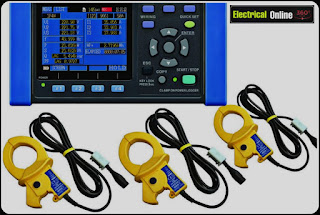How Harmonic Analyzers And Spectrum Analyzers Works?
1. Harmonic Analyzers And Spectrum Analyzers
They are also called as harmonic meters, used to measure harmonic distortion. Harmonic analyzer contains
- Screen for displaying waveform
- Voltage leads
- Current probes
✓ Some harmonic analyzers are handy and some are mounted on cables, while some provide picture of the harmonic distortion that are being measured.
✓ They measure harmonic frequency of voltage and current (till 50th harmonic).
✓ Measured harmonic frequencies are displayed as the bar graph and they can even measure single phase or three phase current and voltage.
✓ Harmonic analyzers are even used to measure power factor.
✓ Ability to measure magnitude and phase angle of harmonics.
✓ Capability to adopt to change in harmonics for change in load.
 |
| Current Probes For Harmonic Measurement |
There are three basic harmonic analyzers :
1. Simple Meters :
It is sometimes used to measure harmonics quickly. They are simple and portable. They are used to measure up to 50" harmonics, rms and THD. They can save the data in the form of the waveform and store the calculated data to PC.
2. General Purpose Spectrum Analyzer :
These devices are used to carry out signal analysis on waveforms for various applications. They are economical in terms of cost; however the device needs careful handling as they are not designed for sampling power frequency.
3. Special Purpose Harmonic Analyzers :
For accurate frequency measurement, the sampling frequency should be twice that of the harmonic frequency. This is called Nyquist criteria.
For measuring current distortion, current probes which use iron core transformer are fitted around the conductor, where measurement is to be made.
2. Transient Disturbance Analyzer
✓ When the sampling rate is high, the transient can be recorded with great accuracy do frequency and magnitude.
✓ Thresholds are set and the device can record the disturbances automatically for a long time.
✓ The amplitude gives the information about the possible damages that can occur on the equipment, while frequency provides the information how the actions can he linked with other circuits.
✓ The obtained information is stored in the tape or on the disk.
✓ While measuring high frequency transients, the wire's length used to link device to the location plays a vital role. Also, cable inductance and capacitance is also important.
There are two types of analyzers:
- Conventional analysers : This records the information like over voltage, under voltage sags, swells with magnitude and duration and Transients.
- Graphic analyzers : They record, save and print real waveforms with all possible information. They are one type of conventional analyzers.
For example, transient which are oscillatory in nature cannot be efficiently explained from their characteristics.
Hence it is required to have waveform capture facility for this type of analyzer for making more analysis on power quality problem.
However conventional analyzers are used at the primary stage for initial check
























0 Comments